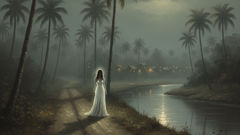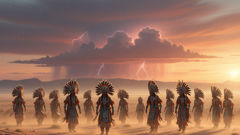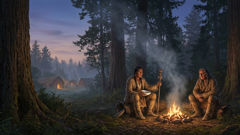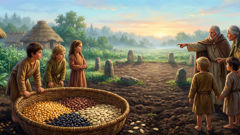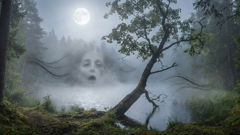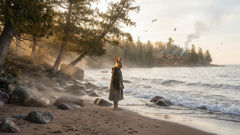Introduction
Along the rain-smudged lanes and limestone hollows of Gascony, older folk still lower their voices when they speak the name Lou Carcolh, the snail dragon that lives half in stone and half in wet shadow. The creature is a study in contradictions: slow of body, infinitely patient; ancient as the shell it carries, yet eager and quick when hunger tightens its heart. Tales told by hearthlight stitch the Carcolh into the land itself—caves that breathe, riverbanks that swallow shoes, rock faces scored like a snail’s spiral. Children learn to keep their distance from cave mouths and to avoid the damp undercuts of rivers, not merely out of fear of slipping but because the earth itself might lift a slimy hand. This legend, like many provincial myths, functions on many levels. It is a warning against curiosity and foolhardiness, a personified hazard of landscape and humidity, and a mirror reflecting communal anxieties about outsiders who arrive at night with unclear intentions. The Lou Carcolh can be read as an allegory for illness and contagion, for the slow, devouring weight of secrets, and for how communities anchor memory in the land. Yet it is also an imaginative creature of grotesque beauty: a serpentine body ringed with barnacled shell, antennae like braided ropes that reach for light and voices, eyes that glisten like wet coins. In the stories passed down from innkeepers and shepherds—some recorded in crude sketches, others only hinted at in the margins of parish documents—a certain consistency emerges: the Carcolh waits in liminal places where the world smells of damp stone and rot, it lures the unwary with music or the illusion of a path, and it leaves traces on the landscape, grooves in rock and the echo of a long, sucking breath. This retelling seeks not only to reconstruct the most evocative versions of the Lou Carcolh legend but to imagine the creature in its environment, to trace its cultural roots in medieval anxieties, and to consider how such a being might have been experienced by real people moving through a hostile, rain-slick world. It is a story built for the slow hours, for readers who will let their eyes follow the snail’s spiral and their minds trace the tentacles into dark water.
Origins, Variations, and the Geography of Fear
The Lou Carcolh’s story is braided from many threads: pagan earth-spirits, Christian demons, practical warnings, and vivid imaginations. To understand the creature, it helps to read it as a product of place. Gascony and neighboring regions of southwestern France are stitched with karst limestone, caves, sinkholes, and subterranean rivers. After long rains the land takes on a distinct smell—damp, mineral, faintly sulfurous—and the edges between path and precipice become unstable. In such terrain even ordinary hazards take on an animating personality. The Carcolh is that personality given teeth. Early accounts of the Lou Carcolh, recorded sporadically in the notebooks of curious antiquarians in the 18th and 19th centuries, are often fragmentary. One parish chronicle mentions a ‘‘grande bête à coquille’’ that ‘‘tirait les sabots des paysans’’—pulled peasants’ boots from their feet and dragged them toward caves. Another account, likely adapted from an oral narrator, insists the creature had ‘‘les yeux d’un bœuf’’ and ‘‘des tentacules comme des lanières’’ that could reach through jobes and under skirts. Where written records are thin or contradictory, oral tradition thickens the narrative. Shepherds of different valleys offered competing descriptions: in one hamlet the Carcolh was more molluscan, a massive shell sliding along the river mud; in another it had a serpentine head and eyes that glittered like pearls, and its tentacles were the size of vines. The diversity in description is itself meaningful; it shows how a single motif—danger that hides in wet places—adapts to local topography and concerns. The Lou Carcolh’s shell may resemble the spiral of local fossils or the rounded boulders that stud the riverbanks, while its slimy body reflects the agricultural reality of a humid climate where crops rot and wounds fester. This melding of the familiar and the uncanny made the Carcolh a more convincing threat: a hazard that was not wholly supernatural, but rather a monstrous extension of natural risks.
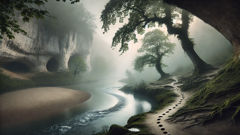
Folklorists have noted that liminal landscapes—places of transition like river bends, cave mouths, marsh edges—are thick with stories worldwide. They’re places where people naturally slow their steps, reconsider their bearings, and tell one another warnings. The Lou Carcolh fits neatly into this pattern. Many versions of the tale emphasize the creature’s patience: it does not chase, it waits. That patience is functionally useful in oral storytelling, too, because it allows for suspense and the insertion of moral commentary. A common moral thread is the fate of the curious or greedy: youths who pluck a bird’s nest, or travelers who linger in the wrong place after sunset, are more likely to encounter the Carcolh. In such tales, the creature acts as the land’s tutor, meting out punishment for transgressions against communal norms—stealing, dishonoring the household, or pressing into private spaces. But not all stories resolve in punishment. Some tell of bargains and bargains turned sour, where the Carcolh becomes a guardian spirit misinterpreted by newcomers, or where a wise woman outwits the beast with salt and song. These variations expose social anxieties about outsiders—traders, vagabonds, or soldiers—entering tight-knit communities and upsetting the fragile balance. In times of plague or economic stress, tales of tentacled beasts that dragged people into watery pits flourished. The Lou Carcolh could thus be read both as a concrete hazard and as a symbolic container for collective fear.
The creature’s physicality—its ratio of shell to soft body, the number and length of its tentacles, the texture of its mucous—varies from telling to telling in ways that illuminate other concerns. When the Carcolh is described as having a vast, barnacled shell, the emphasis is on immovability and permanence: a monstrous stone that might have been part of the landscape itself for centuries. When its tentacles are emphasized, the story foregrounds contact and contamination—sticky, invasive fingers that reach under clothing, ensnare ankles, and leave traces. In many tales the tentacles are not merely weapons but instruments of seduction. They mimic the losing trail of lamplight or the fold of a cloak, they produce faint, human-like sounds that lure the tender-hearted traveler. This seductive element complicates a simplistic moral reading. Some narrators treat the Carcolh as pure malice; others hint at loneliness—an ancient, solitary intelligence that responds to the sound of voices with curiosity. That ambiguity allows the myth to survive social change: the monster remains useful whether it is read as a punitive force or a misunderstood creature of the dark.
Etymology helps anchor the Carcolh in both language and landscape. ‘‘Carcolh’’ resonates with words for coil and snail—spiral forms ubiquitous in the region’s topography and in the marine fossils found in limestone beds. Local dialects preserve variations: quecarcolh, carcolhe, carcol, each variant a small map showing where the tale traveled and how it changed. The continued use of the local name speaks to the Carcolh’s role as a regional identity-marker: in Gascony the creature is not merely a story but a shorthand for a shared set of experiences—foggy knees, swollen rivers, and the unseen drag of the earth.
Encounters, Imagined Natural History, and Cultural Resonance
Stories of encounters with the Lou Carcolh are where the legend breathes. In these encounters the creature becomes a moral actor and a theatrical presence—its tentacles create suspense, its shell anchors the stage, and the setting amplifies the drama. One of the most persistent motifs is the lost child. In multiple accounts a child wanders to the river’s edge to fetch a chick or follow a shiny beetle and returns to the village with wet shoes and an explanation that the ground ‘‘took’’ something—hair, a ribbon, a small shoe. Mothers whisper that a tentacle had brushed the child’s wrist, leaving a residue of silvered mucous. In some variations the child is returned by the beast itself, slightly changed, quieter, with an odd knowledge of the forest. Such tales accomplish several things at once: they warn children against wandering, they provide a narrative frame for unexplained absences, and they allow for communal rituals of purification around water and the uncanny.
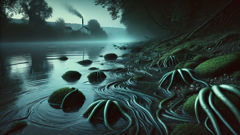
A different set of stories involves grown people—sailors, poachers, itinerant workers—who tempt fate by traveling after sundown or by stealing game near sacred places. These encounters tend to be darker. A poacher who takes more than his share might find himself wrapped in slimy bands and dragged to a hidden grotto, where he witnesses the Carcolh’s lair: a shell-ruled cathedral of wet stone, an accumulation of the creature’s trophies—shoes, wooden bowls, a rosary, sometimes a baby’s rattle. The creature’s lair, in these narratives, functions as a museum of misdeeds, proof that the Carcolh is both predator and curator of human folly. There are also stories of redemption: an old woman who recognizes the beast’s loneliness and places a bowl of milk and warm bread at the cave mouth, after which a tentacle gently curls around her wrist in gratitude, leaving a mark she will carry to her grave as a blessing. These more ambiguous stories complicate the binary of monster and righteous hunter and suggest an uneasy coexistence between people and the invisible forces of landscape.
Imagining the Carcolh as a plausible animal—however fanciful—helps to explain why the tale endured. If we strip the myth of its supernatural gloss and recast it as an exaggerated account of encounters with large gastropods, semi-aquatic serpents, or even the misinterpretation of geological features, the legend remains plausible to an audience accustomed to natural hazards. A glacial-era fossil embedded in a rock face could be told as evidence of a giant shelled creature once roaming the hills; long, ropey roots and submerged branches could be mistaken for tentacles in low light; swollen, slimy riverbanks could conceal sinkholes that swallow feet. Moreover, diseases that produce mucus or discharge—when poorly understood—have often been anthropomorphized as contagions born of monstrous beings. The Carcolh’s mucous trails therefore operate on several levels: they mark territory, they suggest a material danger (slippery surfaces), and they act as a metaphor for disease and the invisible ways harm travels.
The Lou Carcolh also plays a part in local festivals and storytelling economies. In the 19th century, as travel increased and provincial curiosities became commodities, innkeepers and market vendors used the Carcolh legend to draw interest. Guidebooks to the region advertised ‘‘the cave of the Carcolh’’ as a sight, and amateur artists sketched the beast for curiosity cabinets. This commercialization altered the tale’s texture: caricatures emphasized the grotesque, travelers sought a thrill, and local narrators adapted the story for paying ears. Yet commercialization did not entirely secularize the myth; it merely added layers. Some villagers became adept storytellers, specializing in a version of the Carcolh tale that balanced fright and local pride, offering a narrative performance that reinforced communal boundaries even as it invited outsiders in. The Carcolh’s image—coiled shell, rope-like tentacles, and a mouth capable of swallowing a man’s leg—entered postcards, painted signs outside inns, and later, postcards’ descendants: websites and travel blogs that fondly retold ‘‘authentic’’ Gascony myths.
Anthropologically, the Lou Carcolh functions as a symbol of human attempts to domesticate fear. Communities name and narrativize natural dangers in order to shape behavior: keep children away from cave mouths, avoid river edges at night, respect the rhythms of the land. The Carcolh is one of many regional monsters in Europe—like the kraken of the North or the lamia of Mediterranean shores—that embody localized anxieties and practical hazards. Yet the Carcolh’s particular fusion of mollusk and serpent is striking. Molluscan imagery emphasizes slow accumulation and the protection of a soft interior with a hard exterior, while serpentine traits channel movement, predation, and a mythic ability to enter narrow spaces. The combination yields a creature suited to environments where open water meets stone and where a misstep can mean a body dipped in dark current or a leg gone to rot. In this way the Lou Carcolh becomes a narrative tool that helps a community survive: by dramatizing the risk, the tale trains attention and cultivates caution.
Finally, the Lou Carcolh has persisted because it continues to answer modern concerns. In recent retellings the beast sometimes becomes a figure for ecological unease—an ancient being awakened by human disruption, annoyed by pollution, or disturbed by quarrying. This contemporary turn is telling: it recasts the Carcolh from a punitive force targeting individual greed to a creature reacting to larger patterns of environmental harm. In such readings, the mucous trails are not only traces of predation but signs of an ecosystem in distress. Modern storytellers who emphasize these themes tie the old legend to new anxieties, ensuring that the Lou Carcolh remains relevant in an era when the true monsters are often complex systems rather than single beasts.
Conclusion
The Lou Carcolh survives because it is useful and because it is beautiful in a strange way. Its grotesque silhouette—spiral shell, slick body, many-reaching tentacles—gives voice to people’s relationship with place: a relationship shaped by rain, stone, hunger, and long nights. As a myth it performs the work of memory, caution, and identity, encoding practical advice in the drama of encounter and furnishing a theatrical language for communal anxieties. Modern readers can appreciate the Carcolh as a provincial monster and as a symbol: an emblem of how communities narrate danger, reconcile with the unknown, and find a measure of meaning in a precarious environment. Whether viewed through the lens of medieval superstition, environmental allegory, or psychological metaphor, the creature continues to fascinate because it touches on universal themes—curiosity and restraint, loneliness and hunger, the friction between human ambition and the indifferent pulse of nature. The Lou Carcolh is thus less a relic than a living story, one that curves like a shell across centuries, inviting listeners to lean close and decide whether they will be wise or reckless in the face of liminal places. In the end, the legend asks what we owe to the land we walk upon: reverence, attention, and occasionally a bowl left at the mouth of a cave for whatever waits there in the dark.



